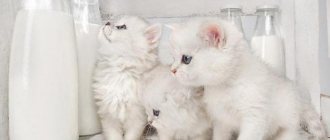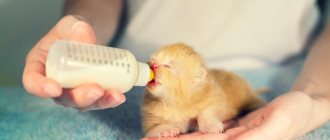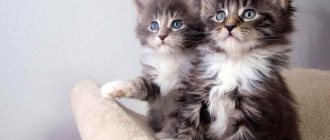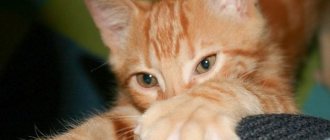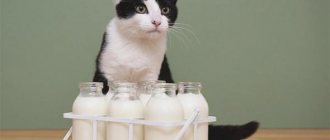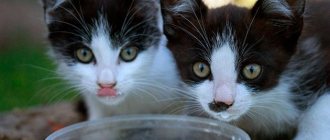Optimal time to start complementary feeding
In the natural environment, breastfeeding lasts about 2 months. But you can introduce complementary foods a little earlier. It is necessary to assess the condition of the kitten and its well-being. A healthy baby at this age can already be fed without special formulas.
It is difficult to determine exactly how many weeks old a kitten comes into a house from the street. You need to show your pet to a veterinarian who can determine its age and choose the right diet. A visit to a veterinary hospital will help assess the health of the animal and provide treatment, if necessary.
General rules for feeding babies are as follows:
- formula milk is used for up to a month;
- at the age of 1-2 months, complementary feeding and solid food are introduced;
- after 2 months, we apply the usual diet of an adult animal.
Kittens that live in a house with a mother cat do not need to be given complementary foods until they are 4 weeks old. During this period, the micro- and macroelements contained in breast milk are sufficient for proper development.
Feeding a suckling kitten
The first complementary food should not be too hard. After all, the baby does not yet know that there is food harder than milk. Oatmeal is great for introducing new foods. It is boiled in water without sugar or salt. Porridge can also be cooked with milk if the kitten does not have diarrhea from it.
The first feeding should be quite liquid
Meat for the baby must be frozen well, then defrosted in the refrigerator. Scrape off some meat, scald it and serve it to the kitten. Perhaps he will not immediately understand that he needs to chew the food. Over time, he will begin to eat with pleasure.
Artificial feeding
There are cases when a cat cannot or refuses to feed kittens, or the baby comes into the house as a newborn. In these cases, it is necessary to provide the pet with artificial feeding that is as close as possible to natural feeding. Specialized milk formulas are available in specialized stores; they are the best option. If such products are not available, you can use cream and milk with various additives in feeding. For example, add a teaspoon of vegetable oil and an egg yolk to a glass of milk.
Rules for artificial feeding:
- 6-7 feedings per day;
- breaks between feedings – from 2 hours;
- food volume per day – 24 ml;
- single dose – up to 5 ml.
Upon reaching 4 weeks of age, the breaks between feedings can be increased, increasing the number of feedings to four times a day. The procedure uses a nipple or pipette.
Supplements for breastfeeding
A cat's milk contains a full range of microelements necessary for kittens if she is well fed. The quality of feeding kittens can be determined by the condition of their fur, bone formation, and activity.
If babies receive good nutrition from their mother, they do not need feeding until 1-1.5 months. Breast milk provides everything needed for good growth and development.
If negative symptoms appear that indicate malnutrition, it is necessary to pay attention to complementary feeding. A food shortage can be judged by the condition of the kittens' fur, lethargy, or constant restlessness, squeaks, and meows. The cause may be the cat's poor diet or insufficient milk supply. Sometimes the mother abandons the kittens without allowing them to eat their fill. Regardless of the reason for the lack of nutrition, it is necessary to replenish it in order to provide babies with good conditions for growth.
When to introduce complementary foods
Ordinary yard kittens can be taken from the mother cat already at the age of one month, starting to gradually feed the baby. They quickly adapt to new conditions, learning to lap milk from a bowl on their own. At one month of age, feeding should be done 7 times a day. Night is excluded.
Pedigree kittens are ready for delivery only in the second month of life.
When choosing ready-made food for a two-month-old baby, there are some rules:
- on a box of dry food, in the “digestibility” column, the corresponding indicator should be at least 80%;
- Before feeding, soak the food in water (never soak it in milk).
You cannot mix prepared and natural foods, since prepared and natural foods are digested differently.
When breastfeeding, complementary foods should be introduced according to the following scheme:
- gradually accustom the kitten to new foods;
- do not introduce all products at once;
- start a new product in small portions.
When trying a new product, you should watch your four-legged family member for a couple of days. Having made sure that the kitten’s stomach has reacted positively, you are allowed to continue “experimenting” further according to the scheme. If there is the slightest change (stool, general condition), immediately cancel this supplement or replace it.
You can often hear the question of how many times and what to feed a kitten without a cat. If for some reason a newborn baby is left without breast milk, then there are the following options:
- find another cat nurse;
- buy a cat milk replacer and feed the baby from a nipple;
- dilute baby formula or goat's milk with water.
The number of feedings is 7–8 times a day, along with night feedings of 30 ml per 100 grams of weight.
Products in the complementary feeding diet
At the age of 1-1.5 months, kittens' need for minerals and vitamins increases sharply. During this period, the skeletal system is formed and teeth are cut through. Complementary feeding, including:
- milk cereal porridges;
- boiled eggs;
- chopped meat or baby meat food;
- curd mass with raw yolks.
The risk of allergic reactions and disruptions in the digestive process can be eliminated by the gradual introduction of various products and monitoring the condition of the pets. At the first stage, complementary foods are introduced every other day; optimal portion sizes must be observed. Kittens have a poorly developed sphincter, which signals the filling of the stomach.
Age 1-2 months
The formation and consolidation of food preferences in kittens occurs during the period from 4 to 8 weeks. The range of permitted foods is gradually expanding and feeding with formula milk is being reduced. Professional breeders give their advice for this period:
- The new product is added to the kittens’ diet little by little, allowing 3-5 days to adapt to it in order to monitor food intolerance. Only one unusual product is introduced at a time, so that in case of a negative reaction (vomiting, diarrhea, bloating), it can be immediately excluded from the diet.
- Along with the new food, kittens should have access to mother's milk or receive the usual formula.
- Babies need to be fed from 3 to 6 times a day, depending on the number of “milk” feedings.
- Place the portion in a porcelain or metal bowl, since plastic can react chemically with food ingredients. In addition, plastic bowls have a specific smell that is clearly distinguishable and very unattractive to the cat’s nose.
Natural feeding
The stomach, intestines and digestive glands of kittens aged 4-8 weeks are already more formed and configured to digest a variety of foods. At this age, the kitten acquires teeth and learns to chew, so it is recommended to add other meat and dairy products to the diet in addition to the already familiar “dishes” (beef scraping, milk porridge and cream), namely:
- low-fat cottage cheese - fed daily;
- pieces of raw chicken or turkey – 1 time every 2 days;
- pieces of boiled low-fat sea fish (pollock, hake, cod) - served once a week;
- chicken egg yolk: raw or boiled - administered 1-2 times a week;
- soft unsalted and low-fat cheese, grated or cut into small pieces - given 1-2 times a week;
- baby meat food in the form of puree or tender pate - for fussy eaters who don’t want to eat raw meat. It is recommended to mix pieces of meat into the puree little by little, teaching the kitten to chew food.
For kittens eating “natural” food, it is necessary to introduce special vitamin and mineral supplements into the diet to form a strong skeleton and muscle corset.
This is especially true for young animals of large breeds, such as:
- savannah;
- Maine Coon;
- chausie;
- ragamuffin;
- Kurilian Bobtail;
- British Shorthair.
Production rations
Dry food for babies aged 4 weeks is pre-soaked and given in the form of a paste, gradually reducing the amount of water week by week. At the same time, kittens are taught to drink water from a bowl, thus replenishing the required amount of fluid in the body. By 2 months, babies are already quite capable of digesting specialized dry food for kittens:
- Royal Canin Babycat 34;
- Orijen Cat&Kitten with chicken or turkey;
- Acana (kitten range).
In addition to dry food, you can use complete wet food (canned food) for kittens aged 1 to 4 months.
Liquid on the kitten's menu
Water plays a vital role in metabolic processes. With a lack of fluid, vital processes slow down, creating a risk of disturbances and malfunctions in the functioning of organs and systems, and development is inhibited. Therefore, water deserves special attention.
Kittens that are fed by a cat do not need additional liquid. But when introducing complementary foods, it is necessary to ensure drinking. Not all kittens readily drink water. If the baby refuses to drink, you need to give him food with a liquid consistency. To do this, add a little water to the food. You can pour it into a separate bowl. In some cases, pets gradually get used to drinking water regularly.
4-7 months – change of teeth
Milk teeth are gradually replaced by molars. For most owners, this process goes unnoticed, since the kittens do not sport gap-toothed smiles, like those of human children, and the lost teeth are most often swallowed.
But sometimes you notice:
- redness of the gums;
- bad breath;
- complete or partial refusal of meat bones.
In the absence of other alarming symptoms, this is the norm. The situation will normalize by itself when the teeth are completely replaced by molars.
But you definitely don’t need to indulge your whims and exclude bones, it won’t do any good. As a compromise, familiar products can be slightly beaten off.
Complementary foods in the diet of kittens of various breeds
The characteristics of the cat breed must be taken into account when introducing complementary foods and preparing a diet. For most species, standard rules apply. But there are breeds that have certain characteristics that require correction in the complementary feeding regime.
Kittens of Scottish and British breeds can receive additional nutrition at an early age. Complementary foods are introduced from 4 weeks.
Maine Coons mature late. Cats usually feed their babies until they are 2 months old. These kittens do not need to be fed complementary foods until they are 8 weeks old.
A special feature of the Sphynx is the lack of hair. This leads to increased energy expenditure to maintain body temperature. At 1.5 months, babies need to be provided with additional nutrition from high-calorie foods.
Nutrition up to one month of age
All of the above is given to the kitten before it reaches one month of age. Then new foods are introduced into the diet.
Chicken yolk begins to be given from 21 days. They just do it extremely carefully. They start with a grain, in the literal sense of the word. If the baby reacted normally to the product, they give a little more. And they closely monitor the baby’s reaction to the innovation.
Prohibited foods for the diet
There are foods that should not be on a kitten's menu. Experienced specialists give several recommendations:
- raw cow's milk is poorly absorbed in the digestive system of babies;
- when milk is diluted with water, its nutritional value decreases, the pet will not receive enough microelements;
- fermented milk drinks in the form of yoghurt, kefir, fermented baked milk are not digested in the gastrointestinal tract of kittens;
- harmful products for children are sausages and cheeses;
- Infection with parasites can occur from raw minced fish.
General Tips
To ensure your kitten grows up healthy, follow these recommendations:
- One day - one new product. Monitor your baby’s well-being and immediately remove food that is not suitable.
- Feed your animal one type of high-quality dry food, without mixing in cheap options.
- If you notice that your kitten has faded fur or frequent diarrhea, consult your veterinarian. Perhaps he needs vitamins. Buy only those prescribed by your doctor. Do not experiment on your pet!
Google, of course, knows everything. But a good doctor is even more. Take care of your furball as if it were your own child.
A happy pet is a well-fed pet
Care in the first days
It is better to feed kittens by holding them. Like babies, they need to be held in an upright position after feeding so that they can burp, releasing excess air.
In the first 2 days
For kittens, it is enough to give 1 teaspoon of milk every 2 hours. The dose should increase as the animals grow. It is advisable to weigh the kittens every day and keep records. If they aren't gaining weight, that should be a red flag.
Starting from day 8
Babies should be given liquid vitamin preparations prescribed by a veterinarian every other day. Raw cow's milk is contraindicated for newborn kittens. You can use ready-made cat milk or dry formulas - cat milk substitutes, which are sold in veterinary pharmacies. In any of the above cases, you will need a bottle and nipple (some manufacturers of ready-made cat milk put the bottle and nipple inside a jar of dry formula). They can also be purchased at veterinary pharmacies. You can use a plastic eye dropper or syringe (without a needle). The main requirement is sterility. Bottles and teats should be cleaned and boiled regularly. The food supply is prepared for no more than 24 hours and stored in the refrigerator.
The food must be heated to 38ºC, and when giving it, you must ensure that the kitten sucks milk itself. Milk should not be introduced by force, as the baby may choke. When the kitten falls asleep or when milk bubbles come out of his mouth, this means that the baby is already full. It is important that kittens suckle themselves through the narrow holes in the nipple and prepare themselves for the “drinking work”. Do not give milk through a wide opening. This often leads to milk entering the respiratory tract and causing pneumonia.
In the first 3 weeks
The kitten should be given 1 teaspoon of artificial food 7-8 times a day (every 2-3 hours, and at night too) with a night break of 5-6 hours. Gradually, the number of feedings should be reduced, increasing the amount of food fed at a time.
At the age of 15-20 days
Teeth are starting to cut, and the cat is not getting enough milk. From this period, kittens need to be fed, gradually transferring them to regular food.
